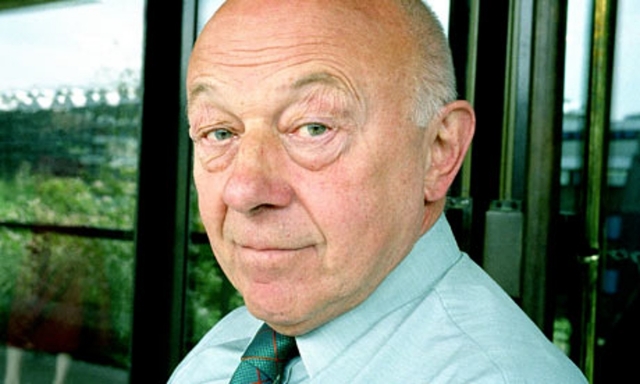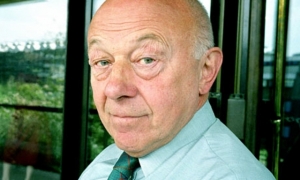Recognizing the Value of the Arts: Sir John Tusa on the Creative Sector
The Creative Industry (CI) makes up 7% of the world’s GDP and is forecast to grow 10% per year. It is growing faster than the manufacture and service industries and is the leading sector for growth and employment in the EU, currently providing 8.3 million jobs and EUR 558 billion revenue.
Late last week the EU-Eastern Partnership Culture and Creativity Programme, with the British Council Georgia, held a seminar for media representatives and prominent members of society to meet with Sir John Tusa, a British arts administrator, radio and television journalist, and former managing director of the BBC World Service.
Sir John began his talk by giving his definition of culture. “The culture of a nation can be divided into many things: It is partly what the nation was, partly what the nation is and it is also what the nation will be. Culture is about all areas of life which are not directly to do with the economy, though there may be connections. Culture would exist even if there was no economy.”
We don’t have time for culture, we are at war
Culture, he added, is the spirit, heart and mind of a nation. Its many elements are part of national identity.
“It is not something which is ‘quite useful,’” Sir John said. “It is an essential part of a nation’s sense of itself. During World War Two, Great Britain said that our culture, our identity, is what we are fighting for. It is a key part of why the nation fought for its independence. Culture is not an add-on, it is a must-have. And it belongs to everyone.”
Start from school
In the UK, what is taught in the public (state) school system often ultimately ends up in the commercial sector.
Sir John gave two examples of this: “The almost seamless connection between the Arts and the commercial sector have only been truly recognized in the past 20 years. The West End theatres, for example, are a commercial success and most actors, directors and producers working there trained in publicly funded schools. Commercial theatre productions begin with the National Theatre (state funded), the Royal Shakespeare Company (state funded) and other smaller theaters either partly or completely funded by the public.
“At the opening of the 2012 Olympic Games in London the two directors were trained in state funded drama schools. And they created an internationally successful event. The world-renowned Olympic Flame Cauldron was designed by Thomas Heatherwick, who trained in art college.”
There is, as you can see from these examples, a very clear and natural connection between what is funded by the state and what ends up in the public commercial sector.
Who should pay?
“There are essentially four systems for funding the Arts:
1) Complete top-down funding, such as that enjoyed by Georgia under the Soviets.
2) The US model- private, corporate funding with very little input from State organizations.
3) The EU system of private funding, such as that used in Germany and France, where there is a strong sense of social-political responsibility.
4) And my favorite- the British system, which has four sources of funding:
State
Private / Corporate
Box office (ticket sales)
Commercial exploitation- capital raised, for example, by theaters renting out their own space.
“In the British system the State will sometimes have its own view of how money might be spent, or the system will consider what audiences or sponsors want. It is democratic to have such dispersed funding,” Sir John said.
“In the UK in the last 50 years, the proportion of funding indirectly from the State has gone down, the amount of funding derived from box office sales, private individuals and corporations has gone up enormously, and the way concert halls are using their spaces [to earn income] has also changed- there has been a big revolution of behaviour and how organizations are run over last 20 years.
“Two months ago, the British Finance Minister and Conservative MP, George Osborne, also known as the Chancellor of the Exchequer, did not cut the Arts Budget. ‘It’s not worth cutting’, he said. ‘Of every pound the Government puts into the Arts, perhaps 8 pounds comes back through employment and taxes.’ It was the first time a Chancellor recognized the real financial value and success of the Arts,” Sir John said.
Defining the Creative Sector
The Creative Industries are activities involving: advertising, architecture, the art and antiques market, crafts, design, designer fashion, film, interactive leisure software (ie. video games), music, the performing arts, publishing, software, and television and radio. Because it was the first definition offered by a government, this original UK definition has been widely adopted by other countries, with sectors adapted based on local commercial and cultural importance.
“I know of no artist who does not want to make money from his work,” said Sir John. “But does that make him part of the creative sector? Well-known English artist Damien Hirst, for example, is an industry. Before the financial crash, Hirst employed 230 people in a factory making ‘original’ Damien Hirst artwork- people paid tens of thousands of pounds for the ‘original’ works of art from the Hirst factory, each signed by him. Was he part of the creative sector? Yes.”
So how did CI develop?
“A definition of Creative Industry was formed only very recently. Even in the UK, the most successful developing country in this sector, awareness of Creative Industry didn’t really exist until 1990. It’s less than 25 years old. A government minister said: ‘I think there is a lot of creative activity going on,’ and went on to commission a survey to find out more. The Government were amazed by just how much activity was found and it was then the British Government accepted Creativity as a sector of the economy. Now, 10% of employment in the UK is in the creative sector and that number continues to grow.”
There is a plethora of activity happening in modern Georgia. One can see it in the theaters, fashion shows, designer hotels (such as Rooms) and art galleries. Yet some compare the Georgia of today to the UK of the 1990s. In the UK, the Creative Industry is now one of the largest single sectors of employment. To make a change in Georgia, the government needs recognize a part of reality of society and the economy: it needs to stand up and recognize that the Creative Sector exists and do everything it can to develop it.
Katie Ruth Davies











